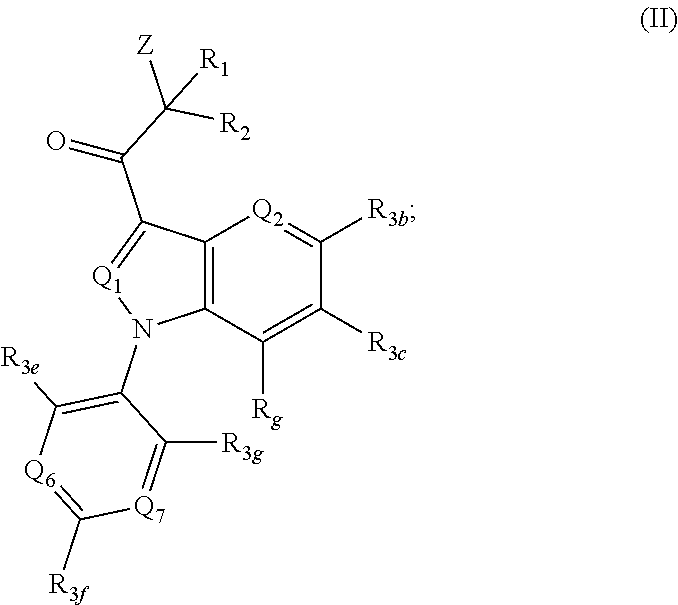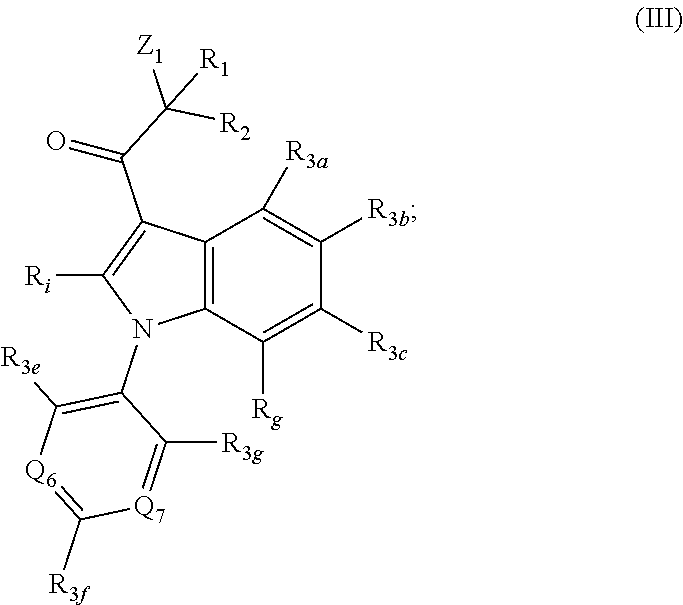Proteasome activity enhancing compounds
a proteasome and activity-enhancing technology, applied in the field of proteasome activity-enhancing compounds, can solve problems such as the presence of toxic protein aggregates, and achieve the effect of enhancing proteasome activity
- Summary
- Abstract
- Description
- Claims
- Application Information
AI Technical Summary
Benefits of technology
Problems solved by technology
Method used
Image
Examples
example 1
4-(2-Methyl-3-(2-(piperidin-1-yl)acetyl)-1H-indol-1-yl)benzonitrile (Compound 160)
[0195]
[0196]Synthesis of 4-(2-Methyl-indol-1-yl)-benzamide (II): A mixture of commercially available 2-methylindole (2.00 g, 0.015 mol), 4-fluorobenzonitrile (3.60 g, 0.030 mol), 18-crown-6 (8.06 g, 0.030 mol) and 37%-potassium fluoride / Al2O3 (30.0 g) in dimethylsulfoxide (100 mL) was heated at 100° C. for 3 hr. After cooling to room temperature, the reaction mixture was filtered and the filtrate was extracted with ethyl acetate (25 mL). The organic extract was washed with water (2×50 mL) and brine. The organic phase was then dried over sodium sulfate and concentrated to obtain the crude product mixture. The crude product was purified by column chromatography on (100-200 mesh) silica using 2% methanol in dichloromethane as the eluant to afford product II (1.40 g, 37%) as a white solid. 1H NMR (400 MHz, DMSO-d6): δ 8.13 (s, 1H), 8.06 (d, J=8.5, 2.1 Hz, 2H), 7.53 (dd, J=8.5, 2.1 Hz, 2H), 7.50 (s, 1H), 7....
example 2
4-(2,6-Dimethyl-3-(2-(piperidin-1-yl)acetyl)-1H-indol-1-yl)benzonitrile (Compound 169)
[0200]
[0201]Synthesis of 2,6-Dimethyl-1H-indole (VI): In a sealed tube, a mixture of m-toludine (5.00 g, 0.046 mol), anhydrous copper (II) acetate (18.6 g, 0.093 mol), palladium (II) acetate (0.208 g, 0.930 mmol) and acetone (25 mL) in dimethylsulfoxide (25 mL) was heated at 90° C. for 18 h. After cooling to room temperature, the reaction mixture was poured into cold water and then extracted with ethyl acetate (2×250 mL). The organic layer was separated and then washed with water and brine. The organic layer was dried over anhydrous sodium sulfate and then concentrated under reduced pressure to afford the crude product mixture, which was purified by column chromatography on (100-200 mesh) silica gel using an ethyl acetate / hexane gradient to afford compound VI (1.0 g, 15%). 1H NMR (400 MHz, CDCl3): δ 10.70 (s, 1H), 7.23 (d, J=8.00 Hz, 1H), 7.02 (s, 1H), 6.72 (d, J=7.8 Hz, 1H), 6.01 (s, 1H), 2.34 (s,...
example 3
4-(6-Isopropyl-2-methyl-3-(2-(piperidin-1-yl)acetyl)-1H-indol-1-yl)benzonitrile (Compound 180)
[0205]
[0206]Synthesis of 6-Isopropyl-2-methyl-1H-indole (X): In a screw-cap vial was prepared a mixture of commercially available IX (5.00 g, 0.037 mol), copper (II) acetate-monohydrate (22.0 g, 0.110 mol), dimethylsulfoxide (30 mL), and acetone (200 mL). The reaction mixture was sparged with nitrogen gas for 30 min and then palladium (Π) acetate (0.170 g, 0.740 mmol) was added. The vial was sealed tightly and then heated to 95-100° C. for 16 h. After cooling to room temperature the reaction mixture was filtered through celite. The filter pad was washed with ethyl acetate (50 mL) and the filtrate was evaporated in vacuo to afford an oil. The oil was poured over ice-water (200 mL) and then extracted with ethyl acetate (3×150 mL). The combined extracts were washed with water (3×500 mL) and then dried over anhydrous sodium sulfate. The organic layer was then concentrated in vacuum and remainin...
PUM
 Login to View More
Login to View More Abstract
Description
Claims
Application Information
 Login to View More
Login to View More - R&D
- Intellectual Property
- Life Sciences
- Materials
- Tech Scout
- Unparalleled Data Quality
- Higher Quality Content
- 60% Fewer Hallucinations
Browse by: Latest US Patents, China's latest patents, Technical Efficacy Thesaurus, Application Domain, Technology Topic, Popular Technical Reports.
© 2025 PatSnap. All rights reserved.Legal|Privacy policy|Modern Slavery Act Transparency Statement|Sitemap|About US| Contact US: help@patsnap.com



